
We're an all volunteer website and need your help to keep going. Here are five ways you can contribute: 1 Donate 2 Buy something 3 Submit a story 4 Volunteer 5 Advertise

New in the gift shop, virtualitalia.com logo wear and use items! 
|
PLEASE NOTE: We are experiencing unexpected
technical difficulties caused by our web host. We apologize for
the inconvenience. During your visit you may experience service
and page interruptions - we are in the process of fixing everything and hope to be
fully back on our feet soon.

ceramics & coffee
Soon, I'll introduce you to Fulvio Taccini, a Majolica artist from Tuscany, who has created a set of Ceramic urns that expresses the deep connection he feels between his craft and coffee.But first, a little background about Majolica.
Majolica enters Europe through
Italy Early examples of this type of ceramic are found in archeological sites of Mesopotamia dating from the ninth or tenth century. During the middle ages traders brought a later version of this pottery to Italy from the port city of Majorca. So, Italians began referring to this tin glazed earthenware as Majorca or Majolica. Tuscany was a center of this type of ceramics as the clay rich riverbeds of the the Arno drew artisans to the region. When Moors were expelled from Spain, refugee potters set up small factories in Italy near these river banks. Italians perfected techniques, developed new glazes and colors and introduced local themes and designs that literally revolutionized this type of pottery production. From Italy, Majolica spread throughout Europe, giving birth such ceramics as Delftware, and Faience-(named after the Italian town of Faenza). Majolica's introduction parallels the path coffee took as it also entered Europe through Italy (via Venice). Italians carefully developed the arts of roasting and brewing and became known as the cradle of coffee culture. Master brewers bring caffine
and art together
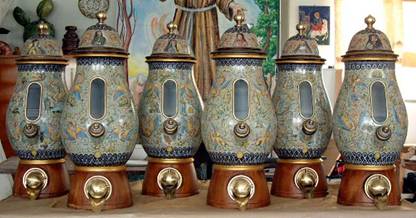 These richly painted vases line the wall behind the counter at the Slitti Coffee and Chocolate shop. Beans are dispensed through a hole in the wooden base and, after weighing, extra beans are returned as dispensing �shovel� fits into an orifice at the bottom of the urn. Master artist brings art
and caffine together Fulvio recalls: "When asked to produce the coffee dispensers I suggested that in the ceramic design we integrate the topic of coffee itself. I knew I would use Raphaelesque decorations as a base. These have been passed down to me by generations of ceramic artists in my family. But I also wanted to tell the story of coffee and its relationship to Slitti and his family's craft." That initiative put Fulvio on an artistic journey that lasted two years! Fulvio studied the history of coffee from bean to cup and its journey around the world. Like many Italians, his love of coffee did not necessarily mean he was preoccupied with the history behind the cup. His natural fondness for a well prepared coffee from well prepared beans --appreciating the traditional care taken in preparing coffee in Italy -- Fulvio was a little embarrassed by the fact that his family brought an automatic pod espresso machine into the studio. "I started reading the literature and preparing numerous drawings of various coffee machines. I learned about local customs in Ethiopia, about the French love of technological exploration and about the various stages in the evolution of the modern espresso machine in Italy. For the final versions of the vases I chose what I thought are the milestones in the story and history of coffee." "Between the traditional Raphalesque scenes of 'grotesque' dragons, griffons and flowing vines, I interlaced images depicting different aspects of the coffee myth and history. These include vignettes such as the discovery of the coffee tree by the goats of the Ethiopian shepherd Khaldi, or the opening of Lloyd's coffee shop in London that later became the famous insurance company). "
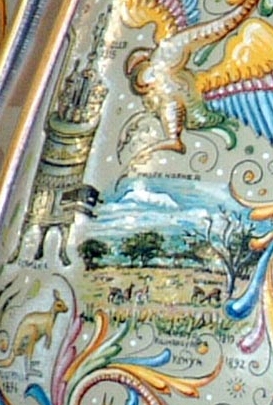 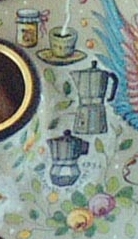 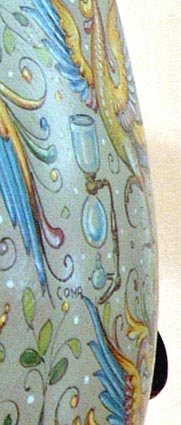 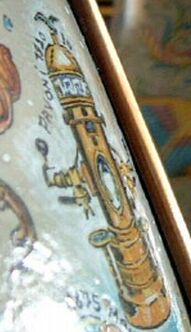 click onto each image to enlarge Besides the historical scenes, many apparatuses used for preparing coffee are pictured: roasters, grinders and various brewers. The latter, in particular, are rich in variety, portraying historical brewers such as the Vienna Incomparable, the Balance, the original Moka Express and the first Gaggia pump driven Espresso machine. Countries important to the cultivation and spread of coffee are represented in miniature landscapes, such as a sunset in Jamaica, a steppe in Kenya and the minarets of Istanbul. Historically accurate drawings of old time sea vessels and the "ship of the desert", the camel, represent the international routes used to move the coffee from it's homelands to your cup. Each vase is capped with a cover adorned with a portrait of a personality who symbolizes that "coffee is a drink that wakes both body and mind" (Fulvio Taccini): Those portrayed are:
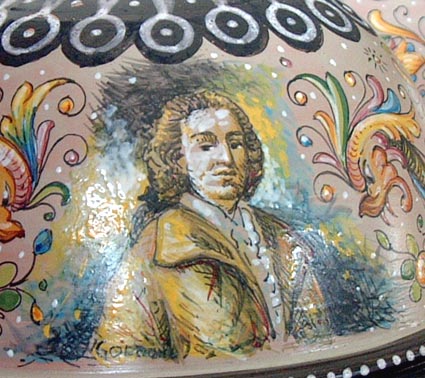 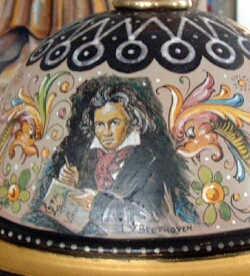 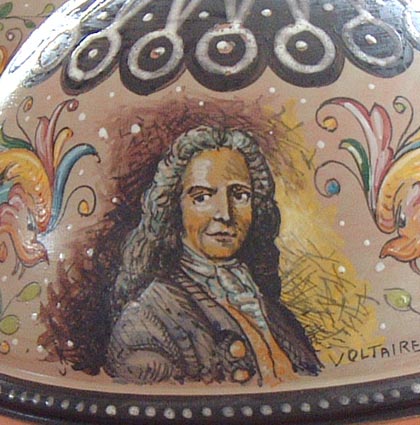 click onto each image to enlarge The six large vases, each one meter high and 40 cm in diameter, have a stately look sitting against the wall in the coffee shop. While their surface is full of what would seem to be incongruous subjects, I found myself drawn into the detailed tapestry of image after image -- their impact is more fully felt when the artwork is viewed in person rather than photos.
Fulvio tells his story " Just like coffee, in the field of ceramics, every region in Italy develops its own distinctive style. We Italians remain faithful to our soil, the air, sun and atmosphere of our region. We let these aspects penetrate our daily life and style. You know, each area in Italy prefers different roasts in their coffee and different hues in their ceramics." "Our family unites all aspects of ceramic work. When we take on a project we cover all phases, working together organically, combining design, modeling and painting. We are dedicated to detailed and conscientious work. This type of attitude is what has made the crafts of ceramic and coffee develop to such heights in Italy." "The love of coffee, like the love of everything in life, is in the details, in grasping the unique ingredients and personal commitment that goes into the human endeavor. The common denominator is commitment to tradition and the will to continually improve, at times to innovate."
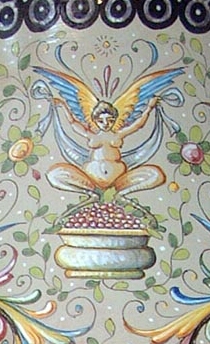 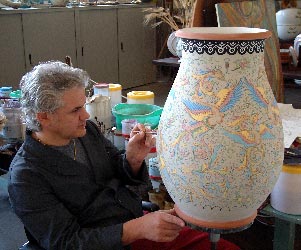 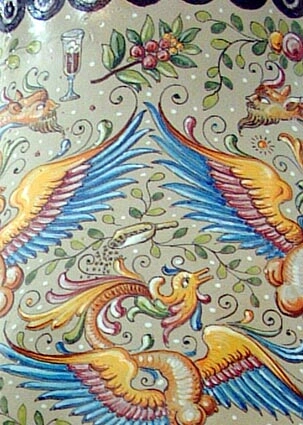 click onto each image to enlarge
"Just like coffee, in our field there has been a slow evolution; constant change and growth as new people confronted with the same raw material -- techniques and methods are perfected. At times, new methods are invented. In the area of ceramic, new designs get added to old while color and glazing techniques progres." "In short, coffee fascinates me: Its history, its aromas and the innumerable ways it can be prepared. A good cup of coffee, like a good ceramic, depends on many factors: good raw material, the quality of water, the method of preparation, the care of the artist and your mood at the time you confront the product." "I took pleasure as Mr.Slitti became actively involved in the work. He was no longer merely a patron paying for a ceramic piece. He became a partner as we learned together and spoke about our crafts. I consider this work to be extremely personal and a milestone for me but it has also become Slitti's work as he joined me in the creation. " "You see, like coffee, ceramic can bring people together."
One can get a sense of the man and his character when meeting his progeny. Related Items:
about the author You can read more of his writings on the I Need Coffee website. |
© 1998-2005 by virtualitalia.com unless otherwise noted
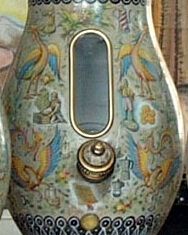 Coffee lovers might connect this
statement to the art of coffee roasting and espresso making, but, quoted from
virtualitalia.com, it refers to the ceramic style Majolica (maiolica) that
flourished in Italy since the Renaissance.
Coffee lovers might connect this
statement to the art of coffee roasting and espresso making, but, quoted from
virtualitalia.com, it refers to the ceramic style Majolica (maiolica) that
flourished in Italy since the Renaissance.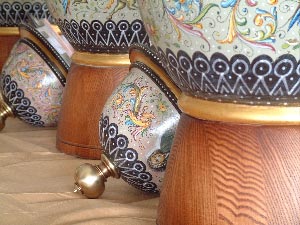 Voltaire: who
claimed that his 40 cups a day made it able for him to "stay wide awake-to
think, think, and think how to combat the tyrants and imbeciles."
Voltaire: who
claimed that his 40 cups a day made it able for him to "stay wide awake-to
think, think, and think how to combat the tyrants and imbeciles."
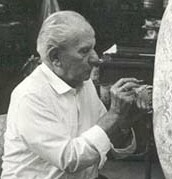 This article is dedicated to the memory
of Orlando Taccini, patriarch of the Taccini Brothers, Alessandro, Vittorio and Fulvio, who passed away March 5,
2003.
This article is dedicated to the memory
of Orlando Taccini, patriarch of the Taccini Brothers, Alessandro, Vittorio and Fulvio, who passed away March 5,
2003.